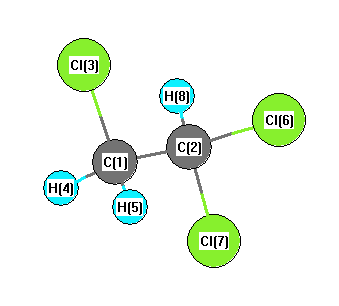Vibrational Frequencies calculated at CCSD(T)/6-31G*
| Mode Number |
Symmetry |
Frequency
(cm-1) |
Scaled Frequency
(cm-1) |
IR Intensities
(km mol-1) |
Raman Act
(Å4/u) |
Dep P |
Dep U |
|---|
| 1 |
A |
3192 |
3071 |
|
|
|
|
| 2 |
A |
3169 |
3049 |
|
|
|
|
| 3 |
A |
3122 |
3003 |
|
|
|
|
| 4 |
A |
1514 |
1457 |
|
|
|
|
| 5 |
A |
1388 |
1336 |
|
|
|
|
| 6 |
A |
1345 |
1294 |
|
|
|
|
| 7 |
A |
1288 |
1239 |
|
|
|
|
| 8 |
A |
1218 |
1172 |
|
|
|
|
| 9 |
A |
1100 |
1059 |
|
|
|
|
| 10 |
A |
981 |
944 |
|
|
|
|
| 11 |
A |
825 |
793 |
|
|
|
|
| 12 |
A |
771 |
742 |
|
|
|
|
| 13 |
A |
696 |
670 |
|
|
|
|
| 14 |
A |
397 |
382 |
|
|
|
|
| 15 |
A |
342 |
330 |
|
|
|
|
| 16 |
A |
264 |
254 |
|
|
|
|
| 17 |
A |
184 |
177 |
|
|
|
|
| 18 |
A |
115 |
110 |
|
|
|
|
Unscaled Zero Point Vibrational Energy (zpe) 10954.7 cm
-1
Scaled (by 0.9621) Zero Point Vibrational Energy (zpe) 10539.5 cm
-1
See section
III.C.1 List or set vibrational scaling factors
to change the scale factors used here.
See section
III.C.2
Calculate a vibrational scaling factor for a given set of molecules
to determine the least squares best scaling factor.
